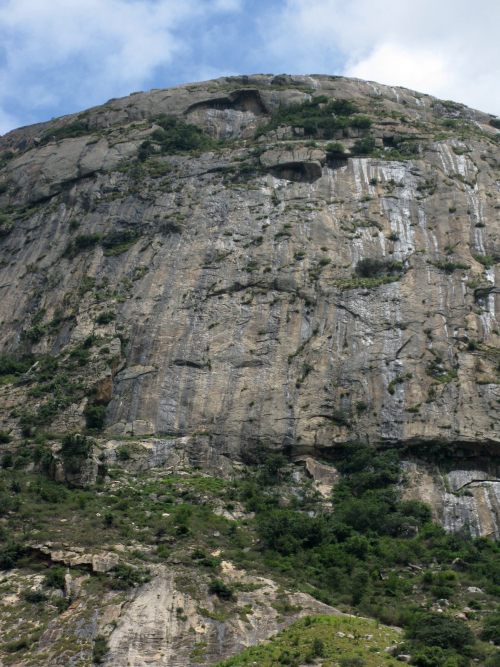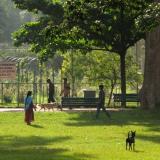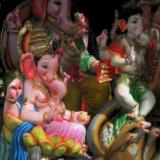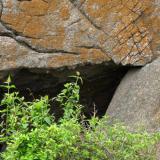
The day after our quick trip to Lal Bagh was our only full day in Bengaluru, so we decided to explore further afield. That morning we set off for that ubiquitous bastion of Bangalore city tourism, Nandi Hills.
Nandi Hills is a small mountain away from the city which is a popular weekend visit amongst the locals, and a common destination for visiting tourists. It has some temples and historical fortifications at the summit, stairs and paths you can climb through the trees, and wonderfully dangerous hairpin bends you can drive through to the top. What’s not to like?
I had been there on some long forgotten previous trip, but it was all fairly fresh for me. Unfortunately, I had underestimated how much I’d used my camera the previous day and forgotten to charge it, so my battery died on me after a few shots of the mountain as we approached it. The perils of modern, electronics-heavy cameras.
Around two thirds of the way up the hill, there is a small parking area with a store. Above this is the fortified area of the peak, and you go through a large stone archway to enter the upper reaches. Cars can go all the way to the top, but we decided to make it on foot and see what sights were available off the ascending tarred road. But before that, we got ourselves some delicious guavas that were being sold at the parking lot. They were served in a popular Indian style, sliced almost completely in four quarters, leaving a bit attached at one end to hold it together, with a mixture of salt and red chilly powder smeared into the cuts to add that extra zing to it. The salt and the spice often makes the guava a dripping jucy mess, but it’s all the better for it, and these particular specimens were truly excellent fruit. We promised ourselves a second round of them on our way back down.
We followed the road up the hill for some distance and then signs indicated there were alternative routes on foot. Our first detour off the road lead us into a small cleared depression where a traditional Indian bath lay hidden. It was a small pool of fresh water encased in a rectangular frame of black stone stairs descended into it. These are a a common sight outside temples in South India and in many places throughout the country, water being an important purifying part of many Hindu rituals. This particular bath was not in regular use, but not completely abandoned. The water was mossy and the monsoons had made everything around it a lush green, including the stone wall that protected it’s periphery. On the other side of it, a canopied path climbed through the lush forest up the mountain. That’s where we headed, treading the wet rusty earth below our feet.
The forest we walked through up steep stone stairs was, unfortunately, not pristine. Everywhere you looked litter decorated the ground and in some cases even the trees. Every manner of snack food packaging and water bottle was on display, which I was quite surprised to see considering the remoteness of this place, as compared to the natural spots we’d visited in the middle of Bombay before. It was obvious many of the visitors were uncouth and the caretakers were not taking a lot of care. A shame.
In spite of that, the forest we walked through was wild and exquisite. It was made all the more beautiful by the fact that it had been raining in recent days, and while no water stood around on the steep slopes, it’s effect could be seen everywhere. The soil was damp, the leaves were washed clean, and the atmosphere was rich with petrichor. The odd bird or insect flew through the canopy, and on tree trunks and barks everywhere, bright red millipedes grazed slowly like miniature cattle. We soon broke out of the trees and into more civilised looking landscapes. The road crossed our route on its way to the top, and signs of structures and paths started to appear as we made our way towards the rocky slopes that lay ahead.
Then, quite suddenly we were at the top, a plateau of bare rock with small patches of grass growing in the accumulated soil in the depressions. The sky was filled with cottony clouds and the wind rushed pleasantly past at this height, a little shy of a thousand metres above the surrounding lands. Over the edge, the world stretched off into the hazy horizon far below our feet. The patchwork pattern of ploughed fields and cultivated plantations created the illusion of an earthen tiled floor with no end.
There were a few small stone shrines at the summit, and monkeys sat around awaiting the inevitable worshippers carrying the inevitable food offerings to the Gods that they could “aquire”. But mostly, a few groups of people took photographs against the windy abyss over the sides, and many simply sat on the warm stone slopes staring quietly into the distance. There is a calm and a peace on the top of mountains that you can’t explain. Yes there is the separation from civilisation, there is the thinner air, the stronger winds, and the more intimate sky, but what makes it unique is something you can never put your finger on. When you’re on top of a mountain, somehow everything makes sense, and you realise none of it really matters, the warm stone comforts your feet and the sky whispers its secrets in the silence.
We went to the very edge of the mountaintop and there in one corner lay a downed windmill. It was a large thing, probably 10 or 15 metres high with a strange vertically rotating aerofoil design. It had been secured to the rock well with metal struts and support wires, but the fierce winds had ripped apart the metal and it now lay on its side, providing another photo-op for visitors. After a while we headed back to the road, this time chosing the more civilised route towards another clutch of shops near the summit. Some hot beverages were had, along with some ice-cream if I remember right, and we drove back down the mountain.
Samir
Liked this article? Please share it: ![]()
![]()
![]()
![]()
![]()
![]()



Nice expedition you did Samir, got a clear panorama of it, what I liked too was your fruity break with gauvas with chili powder, we here have them too, Guayabas, and the chili powder is a part of our culture too.
Thanks for sharing Samir
Magali
Thanks Magali.
I’m not surprised you have gauvas with chili powder. Chili powder is not just also part of your culture, it is in fact from your culture.
India didn’t have the chili plant until it was brought in by the Portuguese a few hundred years ago, from South America. Untill then, India only knew of pepper. It’s strange that chili is such a recent addition to the Indian culture, and now most of us can’t sem to think of food without LOTS of it. 🙂
Samir
No camera? I did not miss the pictures with your very “visual” descriptions. Thanks for sharing.
Now that is very high praise!
Thank you. 🙂
Samir